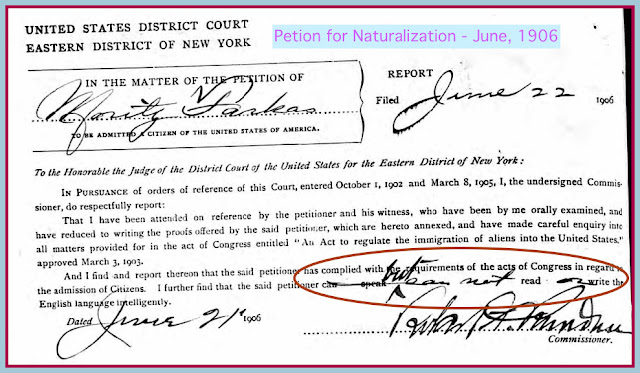When I indexed the 30 years of meeting notes from my mother's
Farkas Family Tree association, I never thought to index the foods so carefully and deliciously described. Those meeting minutes have given me lots of genealogy clues and insights into family history dynamics over the years. This week, I drooled over the talk of food!
The tree (known within the family as the FFT) was formed in 1933 by the adult children of Lena Kunstler Farkas (1865-1938) and Morris Farkas (1857-1936), who left Hungary for a new life in America at the turn of the 20th century.
Since their descendants mostly lived in the New York City area, the tree meetings provided a structure for relatives to see each other often.
Not only did the tree conduct "business," such as purchasing cemetery plots, it also served as a focal point for socializing all year. And socializing means food, right?!
From dessert to full meals
In the first year, a Depression period, only desserts were described, such as home-made cheese strudel served by my great aunt Jennie Katz Farkas (1886-1974) in December, 1933.
It didn't take very long for a little culinary rivalry to creep in. Sometimes meeting hosts and hostesses offered a big spread of delicatessen meats, cheeses and salads. Others prepared roast beef with lots of side dishes, served buffet style.
Turkey wasn't just for Thanksgiving. Given the size of the crowd (at least 15 adults per meeting, plus their children), cooking a turkey made sense. The minutes for one meeting, echoing comments in others, say: "A bee-line was made straight for the delicious turkey, salads, and all the trimmings."
One night late in the 1930s, when the FFT met at the apartment of my maternal grandparents, Theodore Schwartz (1887-1965) and Hermina Farkas Schwartz (1886-1964), the secretary reported in the minutes:
"Our host and hostess for the evening, Ted and Min, rather outdid themselves in the preparation of a meal before this meeting. But the guests did the [hot] dogs--and I don't mean Skippy--justice. But we must not forget the many side dishes accompanying the dogs. Sauerkraut, potato salad, beans, and others were not spared. I am sure the guests of the evening would have preferred to sleep after that, to the "hard" work that they proceeded to put in." [Note: the actual business meeting lasted for an hour, followed by card playing "until all hours."]
War-time meetings and beyond
During World War II, rationing and food shortages forced the hosting families to change their menus, I noticed as I read through the meeting minutes.
One hostess was "congratulated and thanked for the franks and trimmings" she served after business was concluded. How did this come about? A clue in another set of meeting minutes, when a hostess reminded relatives to please bring their ration books so they could get enough of certain foods, especially for holiday meals.
After the war, so many of the members were busy with growing families (marriages, children, grandchildren) that the FFT met less often. The tree organized a yearly summer picnic in the park or at the beach, with barbecued franks and burgers. But no more holiday meals for 50 at home. Instead, the FFT held big Thanksgiving bashes in Manhattan hotels or restaurants during the 1950s, so all members could enjoy the festivities without food prep, cooking, or cleanup.
Here's my great aunt Ella's favorite rice pudding recipe--more custard than rice. She wrote it for 6-8 servings, scaling up for the family tree crowds. She didn't note size of baking dish, probably a buttered two-quart oven-safe pan, so just experiment!
Ella's Custardy Rice Pudding
1/4 cup rice
1 TB butter
1/3 cup sugar
1 tsp salt (for water)
2 1/2 - 3 cups milk (adjust as needed)
3 eggs, well beaten
cinnamon (optional)
Directions: Heat oven to 350 degrees. Meanwhile, boil rice in a lot of salted water. Drain and place cooked rice in oven-safe deep dish. Add butter and sugar to rice, mix, and then pour at least 2 1/2 cups of milk over all, until 1" from top of dish. Mix again. Now fold eggs into mixture, very gently. Top with sprinkling of cinnamon if desired, and bake for 40 minutes. Turn off oven and leave dish in for 10 more minutes. Remove gently, cool on rack for a few minutes, serve warm or chilled.
This is my "Food and Drink" post for Amy Johnson Crow's weekly #52Ancestors prompt.


































